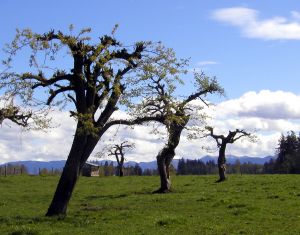Archived News - Orchards
Aristocrats of the Prune Orchards
 Most readers of Focus will know that our area was once famous for the production of a particular variety of plum with excellent eating and preserving qualities. It was also said to be of great value in the straw hat trade in Luton and Dunstable where the locally made straw plait was turned into natty ladies and gents headwear.
Most readers of Focus will know that our area was once famous for the production of a particular variety of plum with excellent eating and preserving qualities. It was also said to be of great value in the straw hat trade in Luton and Dunstable where the locally made straw plait was turned into natty ladies and gents headwear.
The local plums - or more correctly their skins were used to make a dye with which to tint the straw hats in a fetching shade of purple fashionable in the late Victorian and Edwardian periods. Eaton Bray, Edlesborough and adjoining parishes were extensively planted with plum orchards and the trade flourished into the 1950s, but since then these orchards have ceased to be managed for fruit production and are, for the most part either used for grazing or are disused and reverting to scrub.
But they still have a great value for wildlife and support a range of characteristic fungi, lichens, plants, insects, birds and mammals. And some of the old fruit trees support species which are not found anywhere else.
In the depths of last winter's snow and ice some of you may have noticed some odd looking characters, well swathed in weather stopping garments, peering through hedges or over gates, or taking a close interest in any gnarled and ancient orchard trees which could be reached by public footpath or bridle way. They looked odd because they were carrying a heavy load of sample jars, tape measures, ordnance survey maps, assorted paperwork and other gubbins necessary for their business. They were volunteers carrying out an initial survey of the condition of local orchards and their trees on behalf of Natural England and the People's Trust for Endangered Species. If you own or live close to an orchard they may have knocked on your door, or left an information pack about the work.
More specifically they were looking for trees of an age and condition suitable for one of Britain's rarest creatures: a beetle known as the Noble Chafer. This beautiful beetle (see picture on page 73) depends on dead and decaying wood and is found only in traditional orchards, large numbers of which are being destroyed for agriculture or development, or are disappearing through neglect.
The Noble Chafer is a handsome creature. Adults are about 2cm long and a striking, iridescent green in colour. They survive for only 4 to 6 weeks and the very fortunate who live in the areas where they breed may see them on the wing, or visiting flowers such as hogweed, on hot, sunny days in July and August.
They mate at this time and the females lay eggs in the decaying wood of old fruit trees. They prefer orchards with mature trees, 50 to 80 years old – just the sort which are vulnerable to clearance or removal. The larvae feed on the rotting wood, taking two years to develop into adults. During this time the larvae produce characteristic droppings called frass. This often accumulates in the hollows and crevices of the old trees and is an indicator of the presence of the Noble Chafer.
Until very recently the Noble Chafer was believed to survive only in a few orchards in Gloucestershire, Herefordshire and Worcestershire, south Oxfordshire and parts of the New Forest. But no longer! For, as a result of the findings of the initial survey, and a very detailed follow up investigation by specialists in the field, the Noble Chafer has been discovered in an old orchard in Edlesborough. And it may be in others in this area. This is sensational news and has caused great excitement amongst naturalists and wildlife organisations.
If you own, lease or rent an old orchard and are interested in finding out if the Noble Chafer has made its home there you can ask the People's Trust for Endangered Species to send an expert to carry out a survey. Or you can search for "frass" yourself. Collect a handful of the wood mould that has accumulated in a hole or crevice in an old fruit tree. This will be fine, woody material, but it may contain frass, which are lozenge shaped pellets about 3mm long (see picture on page 73). Should you also find larvae in the mould sample, return them carefully to the hole or crevice – but take a photograph if you can. If you find frass or larvae please report your find to the People's Trust for Endangered Species (PTES).
Also contact the PTES if you would like to know more about, or take part in the work to map, investigate and record the condition of old orchards and their wildlife. You can do this by telephone: 020 7498 4533; by e mail: [email protected] ; or by writing to: People's Trust for Endangered Species, 15 Cloisters House, 8 Battersea Park Road, London. SW8 4BG.
Source: Focus, October 2011
Orchard Pruning Course
 Many of our much loved old traditional orchards have been lost in recent years. Those that remain are often in a poor condition due to lack of appropriate maintenance.
Many of our much loved old traditional orchards have been lost in recent years. Those that remain are often in a poor condition due to lack of appropriate maintenance.
This is a real conservation issue because old traditional orchards can be very important places for wildlife.
Rare species such as the Noble Chaffer and Orchard Tooth Fungus are particularly dependant on them and any work to preserve these habitats will benefit much more than just the trees themselves.
This area was particularly well known for it's Aylesbury Prune orchards. Aylesbury Vale District Council Biodiversity Team together with Andy Howard from the Heritage Fruit Tree Company will be running a training event in one of the few remaining Aylesbury Prune orchards, to show you how to safely and effectively manage a traditional orchard. Andy will be demonstrating and instructing on all aspects of orchard management but particularly pruning techniques.
The course will be held at 23 Leighton Road in Edlesborough, starting at 10.30am until 3.30pm, on Wednesday 22nd June 2011. The cost for attendance is £30 and you will be need to bring your own lunch and some appropriate working clothes. All tools will be supplied.
If you are interested in finding out more about the course then please contact Matt Dodds on 01296 427972 or 07843 311844 [email protected] Please apply early because numbers will be limited.
Whether you are wanting to reinvigorate an orchard for fruit production purposes or to benefit the wildlife that depends upon it, this course can really help you achieve your aims.
Matt Dodds
Aylesbury Vale District Council
Traditional Orchards survey
 Can you help us find out more about Bedfordshire's traditional orchards?
Can you help us find out more about Bedfordshire's traditional orchards?
Traditional orchards are a much loved part of our British heritage and countryside. Once they were a common sight, however, over the last 50 years they have declined by almost 60% due to neglect, intensification of agriculture and pressure from land development.
The orchards that remain are home to a host of local varieties of fruit and are also havens for wildlife - bees and other insects pollinating the flowers in spring, lichens flourishing on the bark and birds and insects finding shelter in the decaying wood of old trees.
The People's Trust for Endangered Species is carrying out a nationwide project to compile an inventory of the traditional orchards that still exist. Roughly 240 probable traditional orchards have been identified from aerial photos of Bedfordshire and PTES is now hoping that local volunteers and orchard owners will help them verify these findings by a conducting a simple field survey.
The Bedfordshire & Luton Orchard Group is helping to co-ordinate the survey so if you would like to get involved, please contact Sue Raven on [email protected]
Please help us find out what is left of Bedfordshire's traditional orchards before it's too late!
Many thanks,
Stephen Halton
Senior Project Officer
(Ecology & Community)
Countryside Access Team
Central Bedfordshire Council
Technology House
Ampthill Road
Bedford
MK42 9QQ